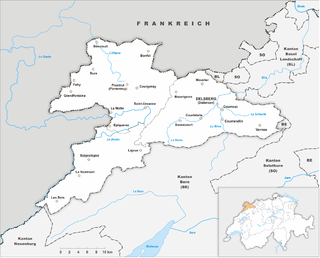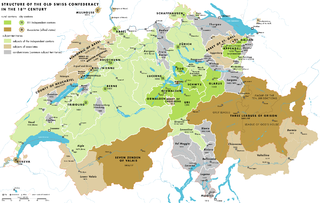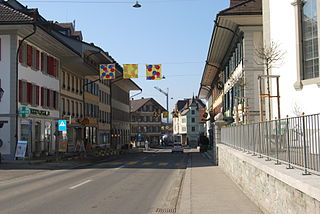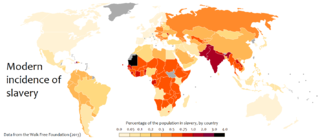
Child labour is the exploitation of children through any form of work that interferes with their ability to attend regular school, or is mentally, physically, socially and morally harmful. Such exploitation is prohibited by legislation worldwide, although these laws do not consider all work by children as child labour; exceptions include work by child artists, family duties, supervised training, and some forms of work undertaken by Amish children, as well as by Indigenous children in the Americas.

The Republic and Canton of Jura, less formally the Canton of Jura or Canton Jura, is the newest of the 26 Swiss cantons, located in the northwestern part of Switzerland. The capital is Delémont. It shares borders with the canton of Basel-Landschaft, the canton of Bern, the canton of Neuchatel, the canton of Solothurn, and the French régions of Bourgogne-Franche-Comté and Grand Est.

Indentured servitude is a form of labor in which a person is contracted to work without salary for a specific number of years. The contract, called an "indenture", may be entered voluntarily for purported eventual compensation or debt repayment, or imposed involuntarily as a judicial punishment. The practice has been compared to the similar institution of slavery, although there are differences.

Coolie is a pejorative term used for low-wage labourers, typically those of Indian or Chinese descent.

The Green Party of Switzerland is a green political party in Switzerland. It is the fifth-largest party in the National Council of Switzerland and the largest party that is not represented on the Federal Council.

The early modern history of the Old Swiss Confederacy and its constituent Thirteen Cantons encompasses the time of the Thirty Years' War (1618–1648) until the French invasion of 1798.

The Historical Dictionary of Switzerland is an encyclopedia on the history of Switzerland. It aims to present the history of Switzerland in the form of an encyclopaedia, published both on paper and on the internet, in three of the country's national languages: German, French and Italian. When it was completed at the end of 2014, the paper version contained around 36,000 articles divided into thirteen volumes. At the same time, a reduced edition of the dictionary has been published in Romansh under the title Lexicon istoric retic (LIR), and constitutes the first specialist dictionary in the Rhaeto-Romance, Switzerland.

Huttwil is a municipality in the Oberaargau administrative district in the Swiss canton of Bern.

Rüderswil is a municipality in the administrative district of Emmental in the canton of Bern in Switzerland.

The Swiss peasant war of 1653 was a popular revolt in the Old Swiss Confederacy at the time of the Ancien Régime. A devaluation of Bernese money caused a tax revolt that spread from the Entlebuch valley in the Canton of Lucerne to the Emmental valley in the Canton of Bern and then to the cantons of Solothurn and Basel and also to the Aargau.

Debt bondage in India was legally abolished in 1976 but remains prevalent due to weak enforcement by the government. Bonded labour is a system in which lenders force their borrowers to repay loans through labor. Additionally, these debts often take a large amount of time to pay off and are unreasonably high, propagating a cycle of generational inequality. This is due to the typically high interest rates on the loans given out by employers. Although debt bondage is considered to be a voluntary form of labor, people are forced into this system by social situations.

Das Hilfswerk für die Kinder der Landstrasse, more commonly known as Kinder der Landstrasse, was a project implemented by the Swiss foundation Pro Juventute from 1926 to 1973. The project aimed to assimilate the itinerant Yenish people in Switzerland by forcibly removing their children from their parents and placing them in orphanages or foster homes. Approximately 590 children were affected by this program.
Beobachter (Observer), also known by its former name Der Schweizerische Beobachter, is a German-language Swiss magazine. Published in Zürich, its 26 issues a year focus on consumer, health and political content.
The Swiss children coercion reparation initiative was a Swiss federal popular initiative to change the federal constitution, which was launched in April 2014.

Child labour in Switzerland was a fact in rural areas to the 1960s, at least tolerated by the Swiss authorities referring to the so-called Verdingkinder, as up to 100,000 children were needed as cheap workers mostly on farms the decades before.

Spazzacamini was the term for child laborers in 19th- and early 20th-century Italy and Switzerland, where they were also known as Kaminfegerkinder in German-speaking areas.
The Schweizerische Ausstellung für Frauenarbeit was an exhibition that took place in Bern in 1928 and in Zürich in 1958. SAFFA was organized by the Bund Schweizerischer Frauenvereine, the Swiss Catholic Women's League (SKF), and 28 other Swiss women's associations, to highlight the precarious situation of working women in the postwar years.
The following is a timeline of the history of the municipality of Bern, Switzerland.

Child auction was a historical practice in Sweden and Finland during the 19th and early 20th centuries, in which orphan and poor children were boarded out in auctions. The name auction, however, does not refer to actual slave auctions, as the children in these auctions were never actually bought in a legal sense, but the name has become the common name for the practice.
Hermann Leuenberger was a Swiss trade union leader and politician.















